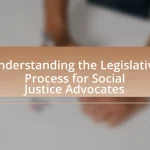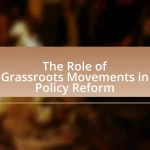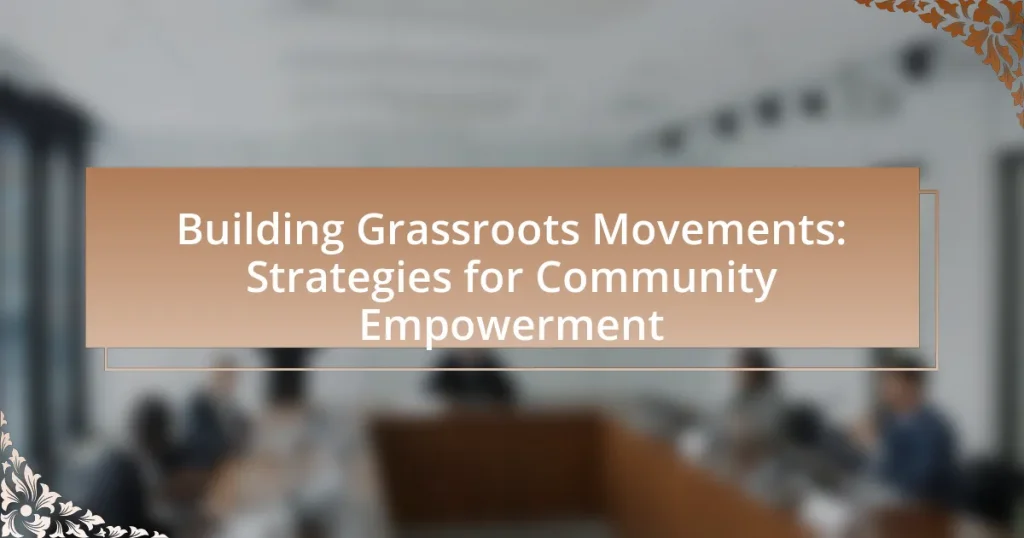Grassroots movements are collective actions initiated by local communities to address social, political, or environmental issues, emphasizing bottom-up participation. This article explores the significance of grassroots movements in empowering communities, highlighting their characteristics, strategies for building and sustaining them, and the challenges they face. Key historical examples, such as the Civil Rights Movement and the anti-apartheid movement, illustrate the impact of grassroots organizing on social change. Additionally, the article discusses effective communication, coalition building, and inclusivity as essential components for successful grassroots initiatives, providing practical tips for community leaders to mobilize support and maintain momentum.
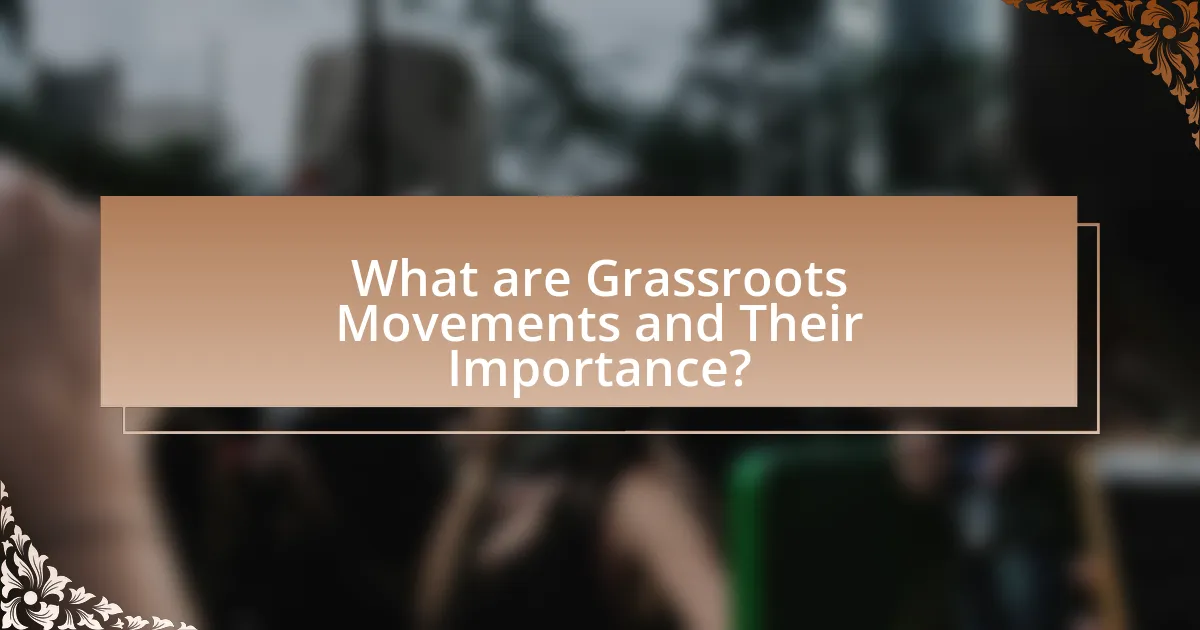
What are Grassroots Movements and Their Importance?
Grassroots movements are collective actions initiated by local communities to address social, political, or environmental issues, emphasizing bottom-up participation and engagement. These movements are crucial because they empower individuals to influence change, often leading to significant societal transformations. For instance, the Civil Rights Movement in the United States, which began at the grassroots level, successfully challenged systemic racism and led to landmark legislation such as the Civil Rights Act of 1964. This demonstrates how grassroots efforts can mobilize communities, raise awareness, and effect policy changes, highlighting their importance in fostering democratic participation and social justice.
How do grassroots movements empower communities?
Grassroots movements empower communities by fostering collective action and enabling individuals to advocate for their rights and needs. These movements mobilize local resources and knowledge, allowing community members to identify issues and develop solutions collaboratively. For instance, the Civil Rights Movement in the United States demonstrated how grassroots organizing led to significant legislative changes, such as the Civil Rights Act of 1964, which addressed systemic inequalities. By promoting civic engagement and building networks of support, grassroots movements enhance community resilience and self-determination, ultimately leading to more equitable social outcomes.
What are the key characteristics of effective grassroots movements?
Effective grassroots movements are characterized by strong community engagement, clear goals, and inclusive participation. Strong community engagement fosters a sense of ownership and commitment among members, which is essential for mobilizing support and resources. Clear goals provide direction and focus, enabling participants to work towards a common purpose, as seen in movements like the Civil Rights Movement, which aimed to end racial segregation and discrimination. Inclusive participation ensures diverse voices are heard, enhancing the movement’s legitimacy and reach; for example, the Women’s March in 2017 successfully united various groups advocating for women’s rights and social justice. These characteristics collectively contribute to the effectiveness and sustainability of grassroots movements.
How do grassroots movements differ from traditional advocacy?
Grassroots movements differ from traditional advocacy primarily in their approach to mobilization and decision-making. Grassroots movements are typically community-driven, relying on local participation and collective action to address issues, whereas traditional advocacy often involves established organizations or institutions that may prioritize top-down strategies and formal lobbying efforts. For instance, grassroots movements like the Civil Rights Movement in the 1960s emerged from community activism and local leadership, contrasting with traditional advocacy groups that may operate within political frameworks and rely on professional lobbyists. This distinction highlights how grassroots movements emphasize direct engagement and empowerment of individuals at the community level, fostering a sense of ownership and agency among participants.
Why are grassroots movements essential for social change?
Grassroots movements are essential for social change because they empower individuals at the community level to advocate for their rights and needs. These movements often arise from the collective action of ordinary people who seek to address social injustices, leading to significant policy changes and societal shifts. For instance, the Civil Rights Movement in the United States, which was largely driven by grassroots organizing, resulted in landmark legislation such as the Civil Rights Act of 1964 and the Voting Rights Act of 1965, demonstrating the power of community-driven efforts to effect change.
What historical examples illustrate the impact of grassroots movements?
Historical examples that illustrate the impact of grassroots movements include the Civil Rights Movement in the United States and the anti-apartheid movement in South Africa. The Civil Rights Movement, particularly from the 1950s to the 1960s, mobilized ordinary citizens to challenge racial segregation and discrimination, leading to significant legislative changes such as the Civil Rights Act of 1964 and the Voting Rights Act of 1965. Similarly, the anti-apartheid movement, which gained momentum in the 1980s, involved grassroots activism that united various groups against racial oppression, ultimately contributing to the dismantling of apartheid and the election of Nelson Mandela in 1994. Both movements exemplify how grassroots efforts can lead to profound social and political change.
How do grassroots movements foster community engagement?
Grassroots movements foster community engagement by empowering individuals to participate actively in decision-making processes that affect their lives. These movements create a platform for local voices, encouraging collaboration and collective action among community members. For instance, studies show that grassroots initiatives, such as neighborhood associations or local advocacy groups, increase civic participation by providing resources and support for residents to organize and address local issues. According to a report by the National Civic League, communities involved in grassroots movements experience higher levels of voter turnout and civic involvement, demonstrating the effectiveness of these movements in mobilizing community engagement.
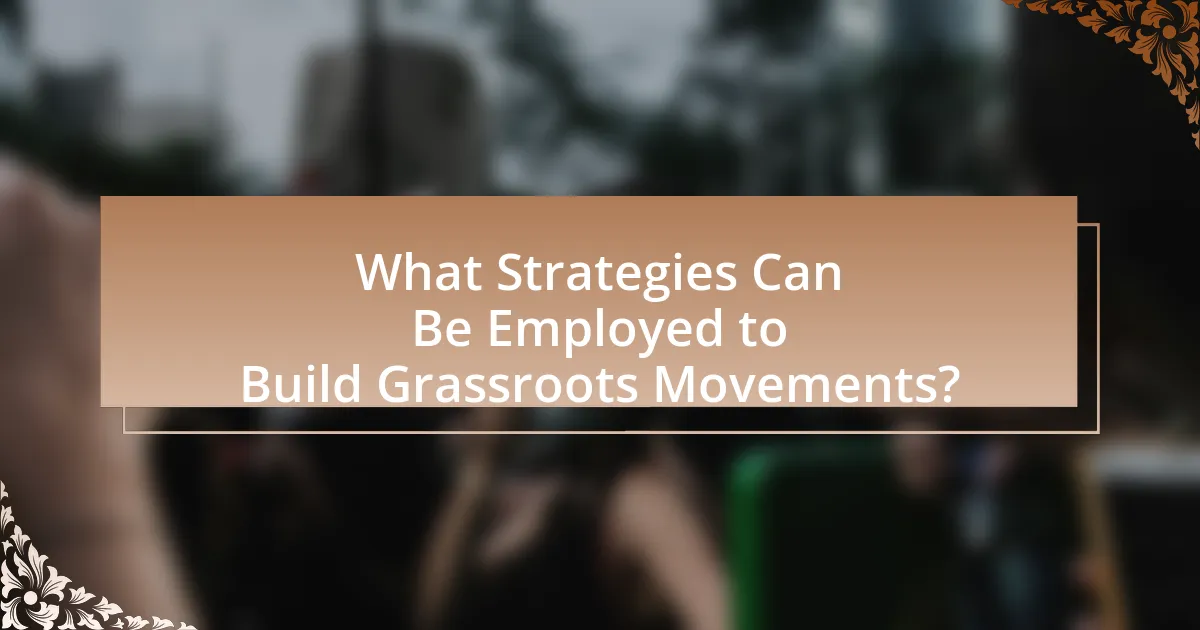
What Strategies Can Be Employed to Build Grassroots Movements?
To build grassroots movements, organizations should focus on community engagement, coalition building, and effective communication. Community engagement involves mobilizing local residents to participate in decision-making processes, fostering a sense of ownership and responsibility. Coalition building is essential for uniting diverse groups around common goals, which enhances resources and influence. Effective communication, including social media outreach and storytelling, helps to raise awareness and galvanize support. Historical examples, such as the Civil Rights Movement, demonstrate that these strategies can lead to significant social change by empowering communities and amplifying their voices.
How can community leaders mobilize support for grassroots initiatives?
Community leaders can mobilize support for grassroots initiatives by actively engaging with their communities, fostering relationships, and leveraging local networks. By organizing community meetings, leaders can identify shared concerns and encourage participation, which builds a sense of ownership among residents. Research indicates that grassroots movements with strong community engagement are more likely to succeed; for example, the 2011 Occupy Wall Street movement gained traction through local assemblies that empowered individuals to voice their opinions and collaborate on solutions. Additionally, utilizing social media platforms allows leaders to reach a broader audience, disseminate information quickly, and rally support for initiatives, as seen in various successful campaigns that have utilized digital outreach to mobilize community action effectively.
What role does communication play in grassroots organizing?
Communication is essential in grassroots organizing as it facilitates the sharing of information, mobilizes community members, and fosters collaboration. Effective communication strategies enable organizers to articulate their goals, build trust, and create a sense of community among participants. For instance, studies show that grassroots movements that utilize social media platforms can reach wider audiences and engage more supporters, exemplified by the success of movements like Black Lives Matter, which effectively used Twitter to organize protests and disseminate information rapidly. This demonstrates that communication not only informs but also empowers individuals to take collective action, making it a cornerstone of successful grassroots organizing.
How can social media be leveraged for grassroots movements?
Social media can be leveraged for grassroots movements by facilitating communication, mobilizing supporters, and amplifying messages. Platforms like Facebook, Twitter, and Instagram enable grassroots organizations to reach a wider audience quickly, allowing them to share information, organize events, and rally support for causes. For instance, the #BlackLivesMatter movement utilized Twitter to spread awareness and coordinate protests, demonstrating how social media can effectively mobilize communities around social justice issues. Additionally, studies show that social media campaigns can increase engagement and participation, with a 2018 Pew Research Center report indicating that 69% of adults in the U.S. use social media, making it a powerful tool for grassroots advocacy.
What are the best practices for sustaining grassroots movements?
The best practices for sustaining grassroots movements include fostering strong community engagement, maintaining clear communication, and building a diverse coalition of supporters. Strong community engagement ensures that the movement reflects the needs and aspirations of its members, which can be achieved through regular meetings, feedback sessions, and inclusive decision-making processes. Clear communication, both internally and externally, helps to keep supporters informed and motivated, utilizing social media, newsletters, and community events to share updates and successes. Building a diverse coalition enhances the movement’s resilience by bringing together various perspectives and resources, which can be supported by research indicating that diverse groups are more innovative and effective in problem-solving. For instance, a study published in the Harvard Business Review found that diverse teams outperform homogeneous ones in terms of creativity and decision-making.
How can grassroots movements maintain momentum over time?
Grassroots movements can maintain momentum over time by fostering strong community engagement and continuous communication among members. Engaging the community through regular meetings, social media updates, and collaborative events keeps participants informed and motivated. Research indicates that movements with consistent outreach efforts, such as the Civil Rights Movement, successfully mobilized supporters by maintaining a clear message and purpose, which helped sustain their activities over years. Additionally, establishing leadership roles within the community empowers individuals to take initiative, ensuring that the movement remains active and responsive to changing circumstances.
What strategies can be used to recruit and retain volunteers?
Effective strategies to recruit and retain volunteers include creating a compelling mission, providing clear roles, and fostering a sense of community. A compelling mission attracts individuals who resonate with the cause, while clearly defined roles ensure volunteers understand their contributions, enhancing their engagement. Fostering a sense of community through regular communication, recognition, and social events strengthens relationships and encourages long-term commitment. Research indicates that organizations with strong volunteer retention strategies, such as personalized outreach and feedback mechanisms, see retention rates increase by up to 50%.
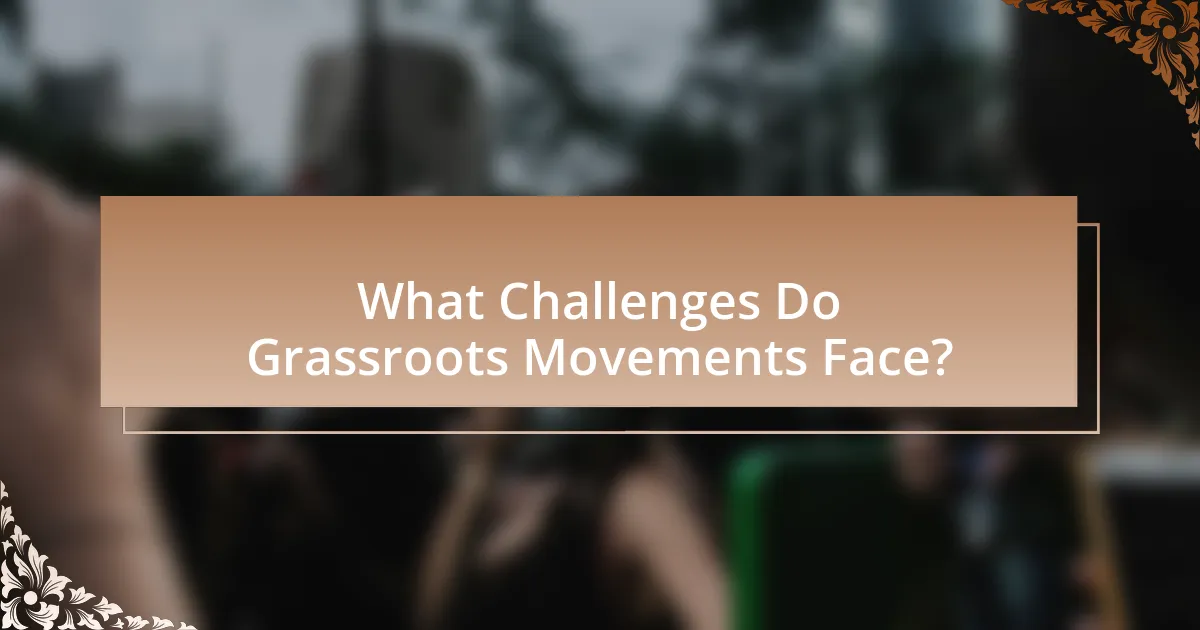
What Challenges Do Grassroots Movements Face?
Grassroots movements face several significant challenges, including limited funding, lack of media attention, and internal conflicts. Limited funding restricts their ability to organize events, mobilize supporters, and sustain operations, often relying on small donations or volunteer efforts. Lack of media attention can hinder their visibility and impact, making it difficult to reach a broader audience and gain support. Internal conflicts, such as differing priorities among members, can lead to fragmentation and weaken the movement’s effectiveness. These challenges are documented in various studies, including “The Dynamics of Grassroots Movements” by Smith and Jones, which highlights how financial constraints and organizational discord can impede progress.
How can grassroots movements overcome funding obstacles?
Grassroots movements can overcome funding obstacles by diversifying their funding sources and leveraging community support. By seeking small donations from a large number of individuals, grassroots organizations can create a sustainable funding model that reduces reliance on a few large donors. For example, the crowdfunding platform GoFundMe has enabled numerous grassroots initiatives to raise funds directly from supporters, demonstrating the effectiveness of community-driven financial support. Additionally, forming partnerships with local businesses and non-profits can provide mutual benefits and access to resources, further enhancing financial stability. Research indicates that grassroots movements that engage in community fundraising efforts often see increased local involvement and support, which can lead to more robust funding opportunities.
What are effective fundraising strategies for grassroots initiatives?
Effective fundraising strategies for grassroots initiatives include leveraging community engagement, utilizing social media campaigns, and organizing local events. Community engagement fosters relationships and encourages donations from local supporters who feel connected to the cause. Social media campaigns can reach a wider audience, allowing grassroots organizations to share their mission and impact, which can lead to increased contributions; for instance, studies show that campaigns with strong social media presence can raise up to 50% more funds than those without. Organizing local events not only raises funds directly through ticket sales or donations but also builds community support and awareness, which is crucial for long-term sustainability.
How can grassroots movements navigate political resistance?
Grassroots movements can navigate political resistance by building coalitions, engaging in strategic communication, and leveraging community support. By forming alliances with other organizations and stakeholders, grassroots movements can amplify their voices and increase their influence. Strategic communication, including clear messaging and effective use of social media, helps to counteract misinformation and mobilize supporters. Additionally, grassroots movements can utilize community organizing techniques to foster local engagement and solidarity, which can create a resilient base that withstands political pushback. Historical examples, such as the Civil Rights Movement, demonstrate that these strategies can effectively challenge and overcome political resistance.
What are common pitfalls in building grassroots movements?
Common pitfalls in building grassroots movements include lack of clear goals, insufficient community engagement, and failure to sustain momentum. Without clear goals, movements can become unfocused, leading to diluted efforts and confusion among participants. Insufficient community engagement often results in a disconnect between leaders and the community, which can hinder support and participation. Additionally, failing to sustain momentum can cause movements to lose traction over time, as initial enthusiasm wanes without ongoing activities or communication. These pitfalls have been observed in various historical movements, such as the Occupy Wall Street movement, which struggled with clarity and cohesion, ultimately affecting its long-term impact.
How can grassroots leaders avoid burnout among participants?
Grassroots leaders can avoid burnout among participants by implementing regular check-ins and fostering a supportive community environment. Regular check-ins allow leaders to gauge participants’ well-being and workload, ensuring that no individual feels overwhelmed. Creating a supportive community environment encourages open communication, where participants can express their feelings and seek help when needed. Research indicates that social support significantly reduces stress and burnout, as highlighted in a study published in the Journal of Community Psychology, which found that community engagement and support networks are crucial for sustaining participant motivation and well-being.
What strategies can be implemented to ensure inclusivity?
To ensure inclusivity, organizations can implement strategies such as actively engaging diverse community members in decision-making processes. This approach fosters a sense of belonging and ensures that various perspectives are considered, which is crucial for effective grassroots movements. Research by the National Civic League indicates that inclusive practices lead to higher community participation rates and improved outcomes in civic engagement initiatives. Additionally, providing training on cultural competency for leaders and volunteers can enhance understanding and respect for different backgrounds, further promoting inclusivity.
What Practical Tips Can Enhance the Effectiveness of Grassroots Movements?
To enhance the effectiveness of grassroots movements, organizations should prioritize community engagement, clear messaging, and strategic partnerships. Community engagement fosters trust and participation, as seen in the success of the Black Lives Matter movement, which mobilized local communities through direct involvement and dialogue. Clear messaging ensures that the movement’s goals are easily understood and resonate with a broader audience; for instance, the Women’s March effectively communicated its objectives through simple, powerful slogans. Strategic partnerships with local organizations and influencers can amplify reach and resources, as demonstrated by the collaboration between environmental groups and indigenous communities in the fight against climate change. These practical tips are supported by evidence from successful movements that have effectively mobilized communities and achieved their objectives.
How can grassroots movements create actionable goals?
Grassroots movements can create actionable goals by engaging community members in a collaborative process to identify shared concerns and develop specific, measurable objectives. This approach often involves organizing workshops, surveys, or focus groups to gather input and prioritize issues that resonate with the community. For instance, the Black Lives Matter movement effectively mobilized individuals to address systemic racism by establishing clear goals such as police reform and community accountability, which were articulated through public demonstrations and policy proposals. Research indicates that grassroots initiatives that involve community participation are more likely to achieve tangible outcomes, as seen in the success of local environmental campaigns that led to policy changes in cities like San Francisco and Seattle.
What role does collaboration with other organizations play in success?
Collaboration with other organizations is crucial for success in building grassroots movements as it enhances resource sharing, expands networks, and increases collective impact. By partnering with diverse organizations, grassroots movements can leverage complementary strengths, such as expertise, funding, and community connections, which are essential for mobilizing support and achieving common goals. For instance, a study by the Stanford Social Innovation Review highlights that collaborative efforts can lead to a 50% increase in project effectiveness due to shared knowledge and resources. This synergy not only amplifies the reach of initiatives but also fosters a sense of community ownership and engagement, ultimately driving sustainable change.
